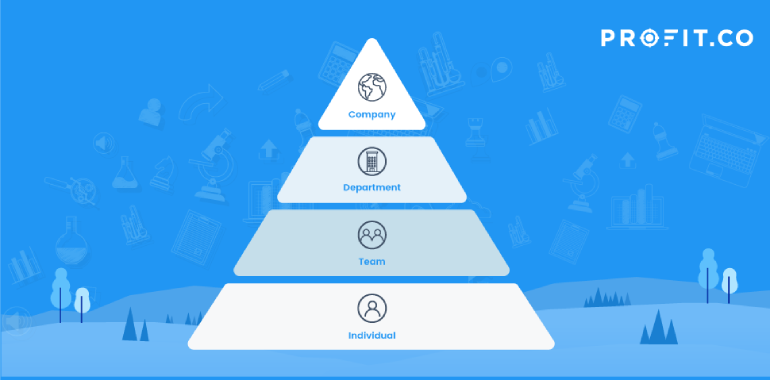When a new team deploys the OKR framework in the organization, many questions arise. Beyond the basics, such as what are OKRs? How do I write a good OKR? There are other questions concerning the pace of their OKR rollout, if their implementation method is right for their organization, and if their OKRs match their team and available resources.
If everyone is moving forward together, then success takes care of itself.
OKRs can be set at four different levels of an organization: company OKRs, department OKRs, cross-functional team OKRs, or individual OKRs. Each OKR level is well-suited for different types of OKRs. Let’s take a closer look at OKR hierarchy and OKR levels so that you can choose the right levels for your OKR adoption.
What are OKR Levels?
In every company, there’s usually an executive team available to act as the leaders of the organization. Individuals at this level are responsible for the strategy of the company. Then, organizations typically have multiple departments to take responsibility for different business functions. There are also some cross-functional teams of smaller sizes that solve particular problems or execute complicated functions. Finally, there are individual employees that fill their unique job roles and fulfill daily tasks to help better the organization. These four distinct groups make up the OKR levels.
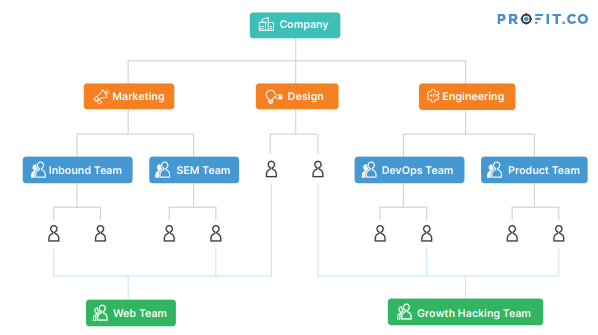
The 4 OKR Levels in an OKR Hierarchy
1. Company Level OKRs
You typically start at the corporate level and set up company OKRs. At this level, your OKRs should be heavily informed by your long-term strategy for the organization. When you have long-term goals that span over the course of a year, you need to choose to use company level OKRs. You will only want to set three or four company OKRs, with between three and five key results for each one.
For example, let’s say you have a company OKR to grow your business:
OBJECTIVE: Grow Revenue
This is your company-level OKR. Fast-forward one quarter, or even one year– how will you know you have achieved this objective? To help answer this question, we’ll write key results that put this qualitative goal into quantitative terms. For example:
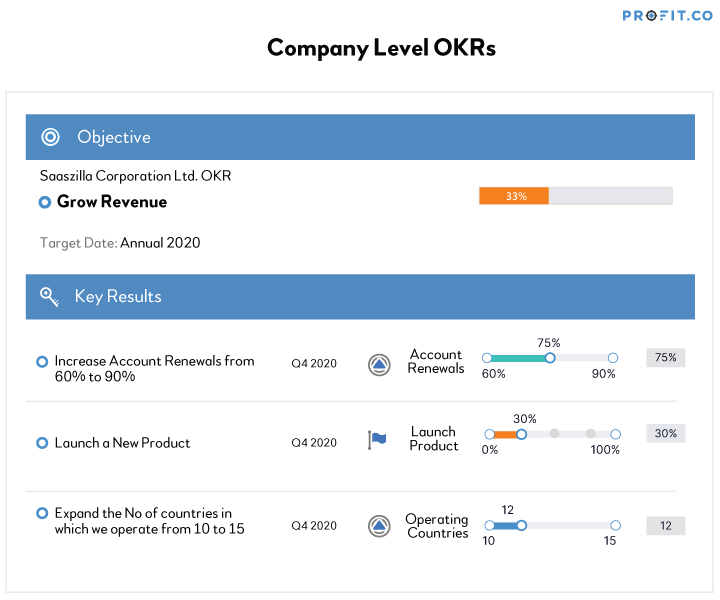
The key results for this company OKR are owned by different departments. At times, a few departments may both be assigned to a key result. With this top-down OKR alignment, also called a cascaded OKR, executives at the company level of the OKR hierarchy will be able to see that the goals they set based on the corporate strategy are communicated clearly to lower OKR levels.
2. Department Level OKRs
Still using the above example for a company OKR, let’s discuss OKRs at the department level of the OKR hierarchy.

Based on the key results written, we can tell the marketing and sales departments will need to be involved in achieving this company OKR.
Marketing has the resources to generate new revenue opportunities as well as identify new markets that the company can enter. The sales team must follow up with the leads provided by the marketing department and move forward in the sales process to stimulate company growth. Knowing this, the first and the third key result will be assigned to the marketing and sales departments.
For the second key result to develop two new products, we’ll need to involve the research and development team. Additionally, manufacturing and other services teams may have to either create additional capacity or introduce new manufacturing lines or plants to support these growth goals. This company level OKR will help inform departmental OKRs.
Let’s build out a department level OKR based on this company OKR.
Based on the company level key result to expand the number of countries in which we operate from 10 to 15, the sales team will create an OKR to Penetrate the Italian Market.
A few key results can be used to measure this objective. One of the key results might be to open a new sales office in Milan, Italy. The key result then will be, open a sales office in Milan by March of this year, or open a Milan sales office before the end of Q1. This key result will give you about three more quarters (Q2, Q3, Q4) to ramp up and ensure a solid execution in the Italian market.
The second key result could be to hire a new VP of Sales for Italy, who will be based out of Milan. It might need to be done earlier than the end of Q1, and thus can be set as the Q1 Key Result.
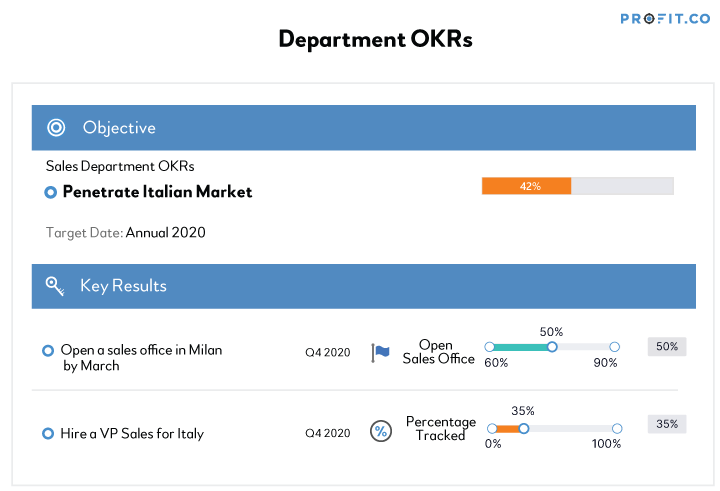
Once you have the location setup and the VP of sales is hired, you can then have a couple of key results to test the market. The third key result for that quarter can be to generate 30 leads for the Italian Market. And finally, the fourth key result can be to increase the number of logos in Italy from 0 to 15. With all these key results set up, you can focus and execute aggressively for the next three quarters. You will have a local office in Milan, hire a regional VP of Sales, and have demonstrated the ability to generate leads and onboard logos.
This OKR for the sales department ties back to the company OKR and its key result to increase the number of countries in operation from 10 to 15. In many companies, setting department and company level OKRs is more than enough to get rolling with your OKR program and start to see significant results from quarter to quarter. Horizontal alignment between departments will help each sector of the company fulfill their target outcomes– for example, the sales team might ask for support from HR, marketing, and Customer success to help meet their key results.
If you are looking for an agile and intuitive software to help manage your OKRs and maintain transparency and alignment throughout the entire quarter, you can get started for free on Profit.co today!
3. Cross-functional team level OKRs
In most company’s OKR programs, departments are not in silos that can operate without the support of other teams. In fact, you’ll find that many key results cannot be owned and executed by one department. Instead, you’ll need individuals from various departments to help fulfill a specific key result.
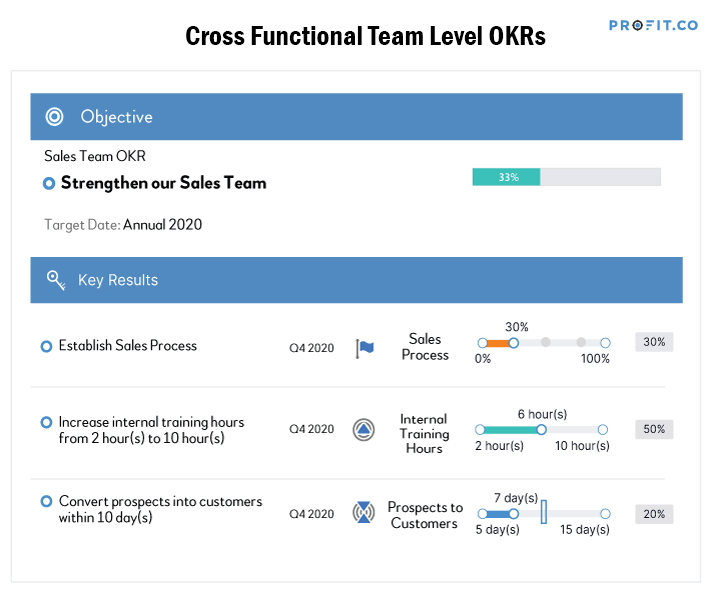
Let us review the OKR to “Breach the Italian Market.” Opening a sales office in Milan could be the responsibility of the company’s Facilities Management department, while the Sales department leads the initiative because they are responsible for ensuring the office is successful.
Hiring the VP of Sales will be heavily informed by what the Sales department wants, but ultimately the interview and onboarding process must be supported by the HR department and the Chief Executive’s Office.
For initiatives that require the full attention of employees in multiple departments, leaders should consider creating a cross-functional team to own and execute the OKR. Whether a business elects to have separate departments that are aligned horizontally, or cross-functional team OKRs, the communication and clarity of OKRs must be prioritized above all else.
4. Individual OKRs
Finally, companies can choose to set OKRs at the individual level. Employees can have their own OKRs that they are accountable for. These OKRs are commonly informed by department- or team-level key results.
For example, the department-level key result “Increase the number of new leaders in the Italian region from 0 to 30” could potentially become the objective for the Demand Generation or Marketing Director.
If the director needs 30 new leads from the Italian market in a quarter, they will ask themselves what steps they need to take or outcomes they need to see in order to help generate these leads.
The director’s solution might be to run Google Ads, LinkedIn Ads, or run advertisements in newspapers or magazines.
Additionally, they can elect to write some PR announcements that the company is entering the Italian market, as well as arrange a press conference to get the message out. All these initiatives result in creating awareness in the market.
Once awareness increases, potential clients are more likely to find the business. A website or landing page can help promote sign-ups and demos, generating new leads.
What is the ideal way to roll out OKRs?
Like anything with the OKR framework, the “ideal” way to roll out OKRs entirely depends on your organization. It’s important to consider your company’s experience with OKRs and the maturity of your OKR program. These will be significant factors in deciding which levels you want to set OKRs at, and your approach to implementing OKRs in your organization.
If your business is just starting out with OKRs, then having too many OKR levels in play will result in a complex and potentially confusing OKR environment. Instead, it’s smart to limit yourself to two OKR levels and add more when needed.
The general recommendation for companies just getting started with OKRs is rolling out department and company level OKRs first, and running your program for a few quarters before adding any cross-functional team or individual-level OKRs.
With this approach, all team members will understand :
- The function of OKRs
- How to create objectives
- How to write a good Key Result
- How to measure key result progress
If you first introduce employees to OKRs at the individual level, employees may fear that they are being evaluated and micromanaged. This concern can limit their willingness to set aspirational and stretch objectives. Meanwhile, if you start with company-wide and department OKRs and then slowly expand your OKR program as needed, employees will have a better understanding of the core principles of OKRs and how they can stretch their personal goals and contribute to the higher-level goals of the company.
Final Thoughts on OKR Levels
One of the most important decisions to make when launching your OKR program is to decide which levels you will set OKRs at. Be sure that you are considering your company’s history, the kind of goals you want to achieve, and your team’s familiarity with OKRs.
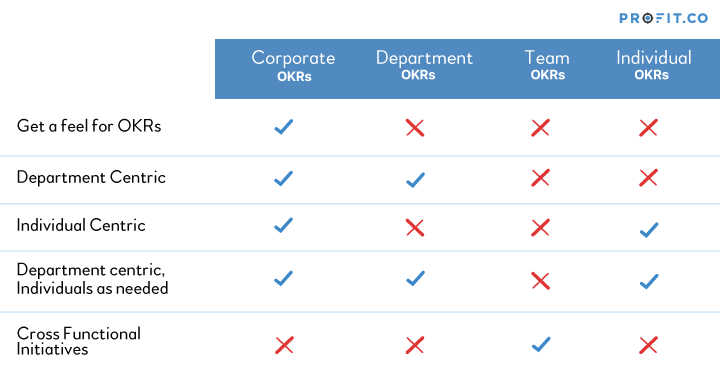
Most businesses use two or three levels over the course of their OKR program. You don’t have to pick one level or approach and stick with it. The beauty of the OKR framework is that it is an agile way to execute your strategy quarter to quarter as your company grows and your needs change. Having an agile and intuitive OKR software like Profit.co to help you make quick changes and pivot according to your company’s needs is the key to proper growth and development with the OKR framework.
To further enhance your OKR implementation and ensure mastery of the methodology within your organization, consider pursuing OKR certification. Obtaining OKR certification can provide your team with the necessary expertise to effectively deploy and manage OKRs at all levels of your organization.
Additionally, implementing Balanced Scorecard Software can complement your OKR framework by providing a holistic view of your organization’s performance across multiple dimensions. This can help ensure that all strategic goals are aligned and progress is tracked effectively.
